Unit 4 Body language-Extensive reading
文档属性
| 名称 | Unit 4 Body language-Extensive reading | 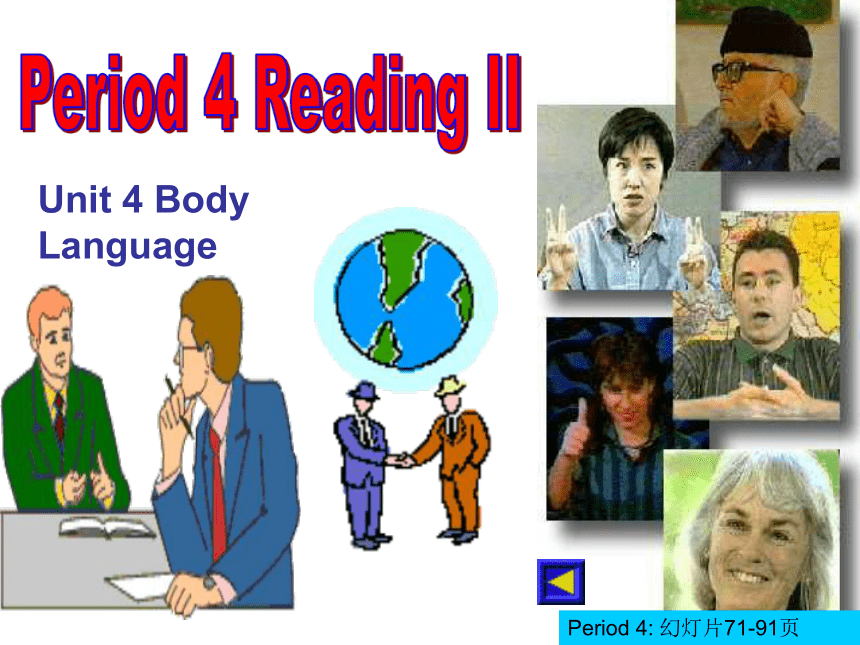 | |
| 格式 | rar | ||
| 文件大小 | 820.7KB | ||
| 资源类型 | 教案 | ||
| 版本资源 | 人教版(新课程标准) | ||
| 科目 | 英语 | ||
| 更新时间 | 2011-12-09 11:55:15 | ||
图片预览

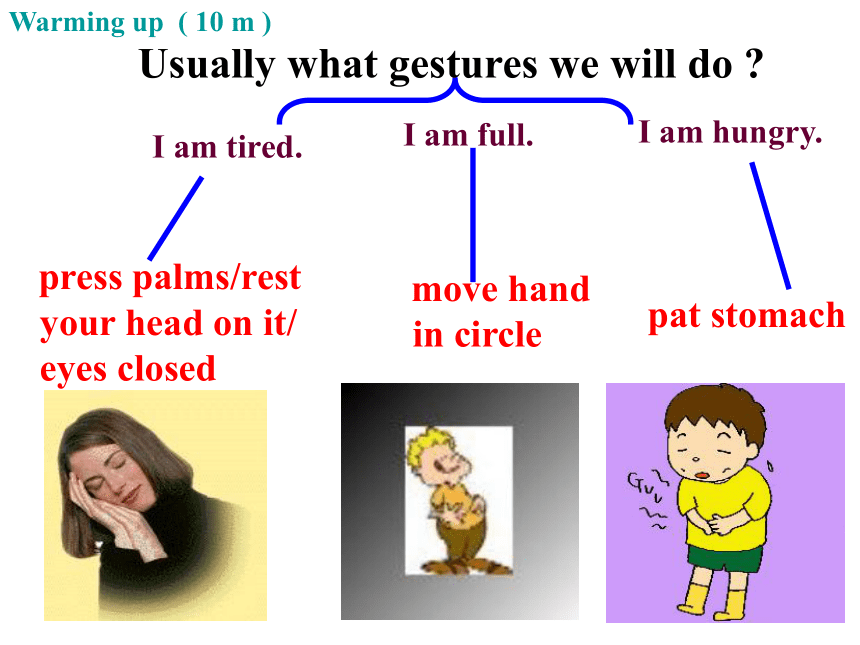
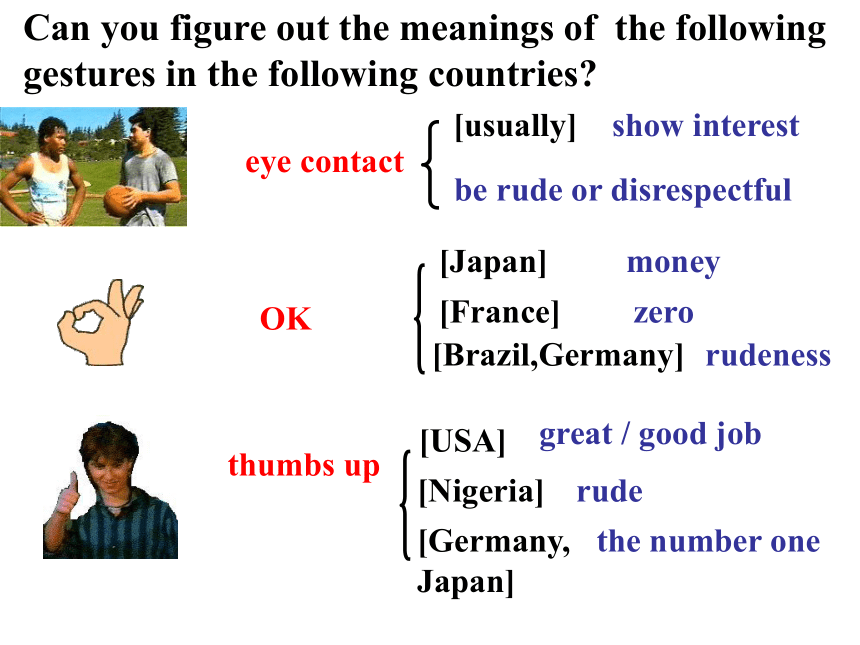
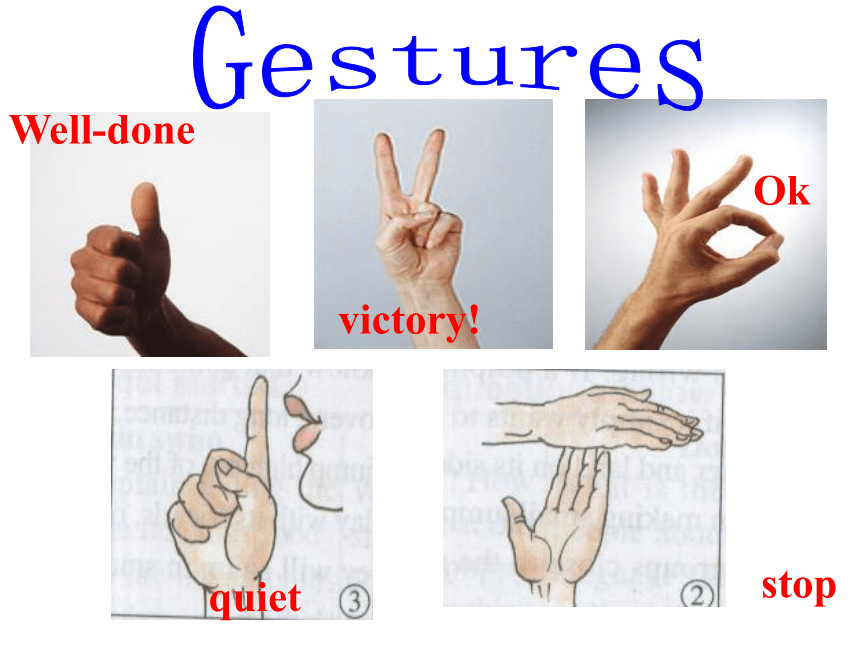
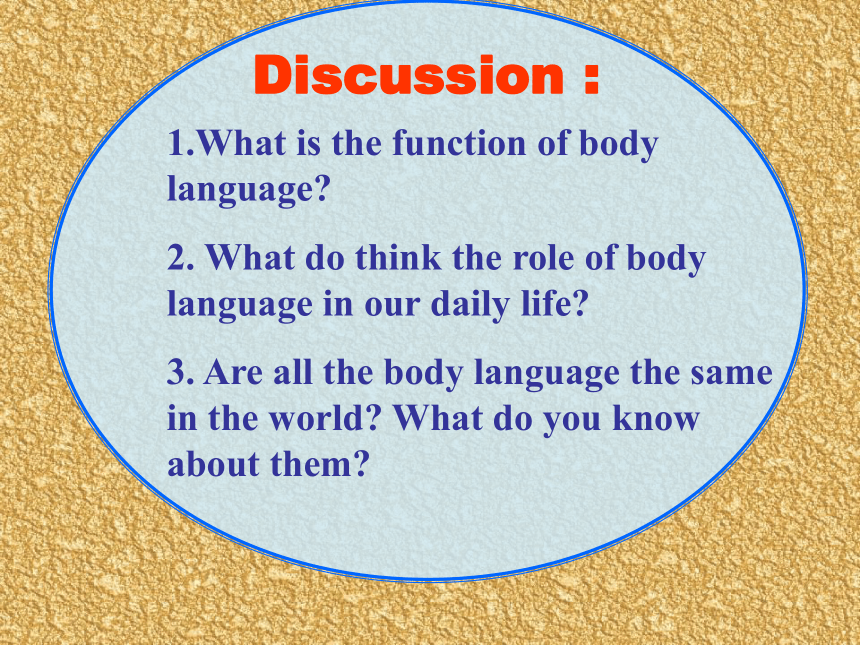
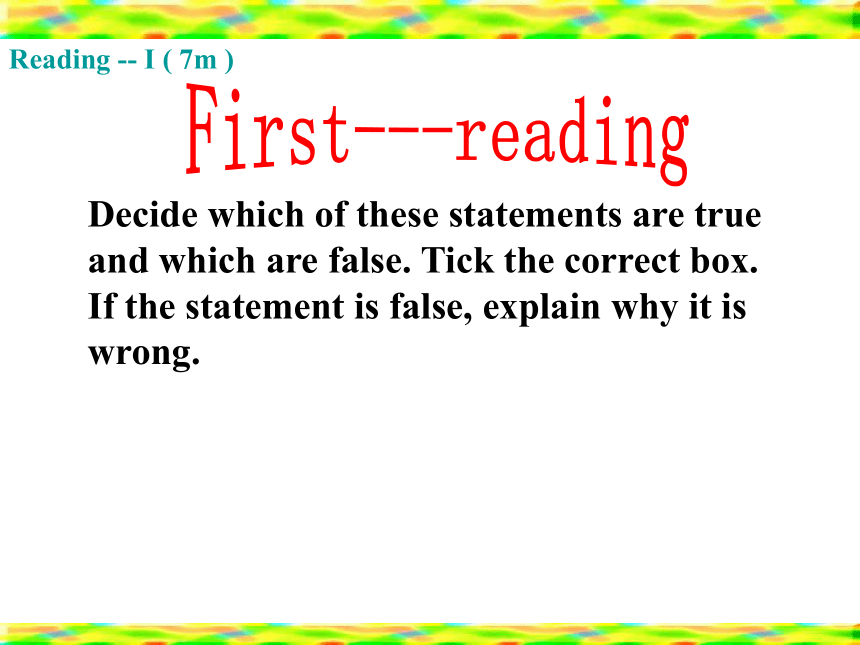
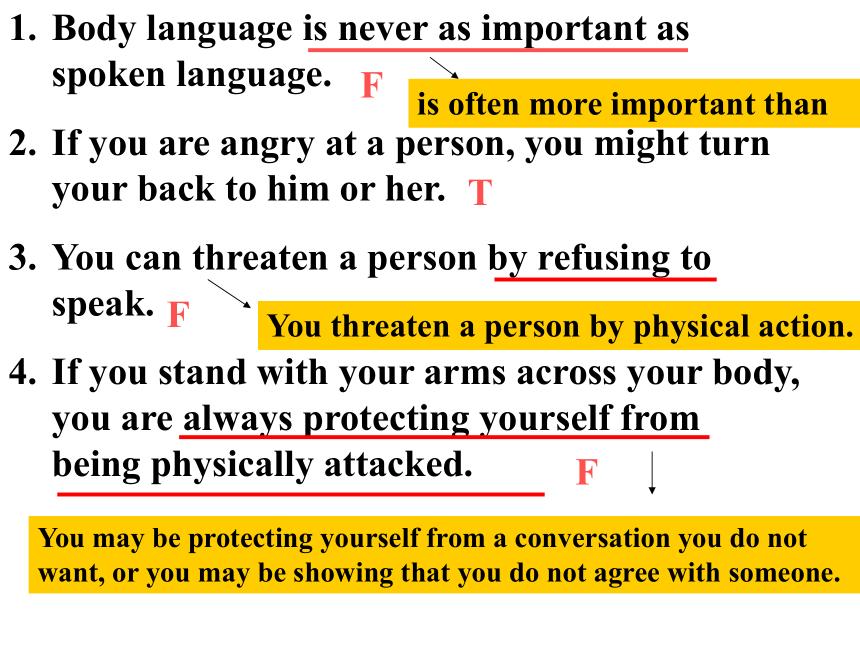
文档简介
(共21张PPT)
Unit 4 Body Language
Period 4: 幻灯片71-91页
I am tired.
I am full.
I am hungry.
press palms/rest
your head on it/
eyes closed
move hand
in circle
pat stomach
Usually what gestures we will do
Warming up ( 10 m )
show interest
be rude or disrespectful
money
zero
rudeness
[USA]
[Nigeria]
[Germany,
Japan]
OK
eye contact
thumbs up
Can you figure out the meanings of the following gestures in the following countries
the number one
rude
great / good job
[Brazil,Germany]
[France]
[Japan]
[usually]
Well-done
Ok
stop
quiet
victory!
Discussion :
1.What is the function of body language
2. What do think the role of body language in our daily life
3. Are all the body language the same in the world What do you know about them
Decide which of these statements are true and which are false. Tick the correct box. If the statement is false, explain why it is wrong.
Reading -- I ( 7m )
Body language is never as important as spoken language.
If you are angry at a person, you might turn your back to him or her.
You can threaten a person by refusing to speak.
If you stand with your arms across your body, you are always protecting yourself from being physically attacked.
F
is often more important than
T
F
You threaten a person by physical action.
F
You may be protecting yourself from a conversation you do not want, or you may be showing that you do not agree with someone.
5. If you sit looking away from a person, or with your back turned, you are saying you are not interested in that person.
6. You should not greet your new boss by giving her or him a hug.
7. Body language is the same all over the world.
8. Most people can understand each other if they try.
T
T
F
sometimes the same, but it is sometimes quite different.
T
Try to find some of the body language which shows similar feelings or ideas and some which shows different feelings or ideas in different cultures.
Reading -- II ( 10m )
similar body language
1.frowning or turning one’s back to someone
to show anger
2. closing one’s hand and shaking it at someone
to threaten that person
3. nodding the head up and down
to show agreement
similar body language
4. shaking the head
to show disagreement or refusal
5. looking away from a person or yawning
to show no interest to the person
6. standing, holding your arms across your chest
to protect yourself from an unwanted conversation
similar body language
7. sitting, looking at and turning towards the person you are talking to
8. rolling your eyes and turn your head away
to show you are interested
to show you do not believe what you hear or you do not like it
different body language
1.children’s looking directly at an adult in Asia and South America
not good behavior
2.children’s not looking directly at the teacher in North America
to get punishment from their teachers because they think the children are not telling the truth
misunderstanding
2. standing too close to your boss or teacher
3.a hug to your boss or teacher
not acceptable
probably not a good idea to show respect
1. a smile
smile
Universal gestures
A smile does not always mean that one is happy.
A smile can hide other feelings, such as anger, fear or worry.
If someone “loses face” they may smile to hide it.
A smile usually intends to put people at ease.
Post –reading Discussion:
How can we know other’s feelings, even if they do not speak to us
Why should we be careful of our own body language
Why is it important to watch others as well as listen to them
Discussion ( 5m )
Giving Performance
Please act out according to the following situations(choose either one):
Presentation ( 8m )
Situation 1: You are meeting a British friend in the airport, and you are going to hug him. Imagine what will happen.
Situation 2: You are visiting in another country, and you want to cut hair, but you have difficulty in communicating. How can you communicate with the barber with body language
Homework:
Read the passage in Reading Task on P66 and then finish the exercise on P67.
Unit 4 Body Language
Period 4: 幻灯片71-91页
I am tired.
I am full.
I am hungry.
press palms/rest
your head on it/
eyes closed
move hand
in circle
pat stomach
Usually what gestures we will do
Warming up ( 10 m )
show interest
be rude or disrespectful
money
zero
rudeness
[USA]
[Nigeria]
[Germany,
Japan]
OK
eye contact
thumbs up
Can you figure out the meanings of the following gestures in the following countries
the number one
rude
great / good job
[Brazil,Germany]
[France]
[Japan]
[usually]
Well-done
Ok
stop
quiet
victory!
Discussion :
1.What is the function of body language
2. What do think the role of body language in our daily life
3. Are all the body language the same in the world What do you know about them
Decide which of these statements are true and which are false. Tick the correct box. If the statement is false, explain why it is wrong.
Reading -- I ( 7m )
Body language is never as important as spoken language.
If you are angry at a person, you might turn your back to him or her.
You can threaten a person by refusing to speak.
If you stand with your arms across your body, you are always protecting yourself from being physically attacked.
F
is often more important than
T
F
You threaten a person by physical action.
F
You may be protecting yourself from a conversation you do not want, or you may be showing that you do not agree with someone.
5. If you sit looking away from a person, or with your back turned, you are saying you are not interested in that person.
6. You should not greet your new boss by giving her or him a hug.
7. Body language is the same all over the world.
8. Most people can understand each other if they try.
T
T
F
sometimes the same, but it is sometimes quite different.
T
Try to find some of the body language which shows similar feelings or ideas and some which shows different feelings or ideas in different cultures.
Reading -- II ( 10m )
similar body language
1.frowning or turning one’s back to someone
to show anger
2. closing one’s hand and shaking it at someone
to threaten that person
3. nodding the head up and down
to show agreement
similar body language
4. shaking the head
to show disagreement or refusal
5. looking away from a person or yawning
to show no interest to the person
6. standing, holding your arms across your chest
to protect yourself from an unwanted conversation
similar body language
7. sitting, looking at and turning towards the person you are talking to
8. rolling your eyes and turn your head away
to show you are interested
to show you do not believe what you hear or you do not like it
different body language
1.children’s looking directly at an adult in Asia and South America
not good behavior
2.children’s not looking directly at the teacher in North America
to get punishment from their teachers because they think the children are not telling the truth
misunderstanding
2. standing too close to your boss or teacher
3.a hug to your boss or teacher
not acceptable
probably not a good idea to show respect
1. a smile
smile
Universal gestures
A smile does not always mean that one is happy.
A smile can hide other feelings, such as anger, fear or worry.
If someone “loses face” they may smile to hide it.
A smile usually intends to put people at ease.
Post –reading Discussion:
How can we know other’s feelings, even if they do not speak to us
Why should we be careful of our own body language
Why is it important to watch others as well as listen to them
Discussion ( 5m )
Giving Performance
Please act out according to the following situations(choose either one):
Presentation ( 8m )
Situation 1: You are meeting a British friend in the airport, and you are going to hug him. Imagine what will happen.
Situation 2: You are visiting in another country, and you want to cut hair, but you have difficulty in communicating. How can you communicate with the barber with body language
Homework:
Read the passage in Reading Task on P66 and then finish the exercise on P67.
同课章节目录
